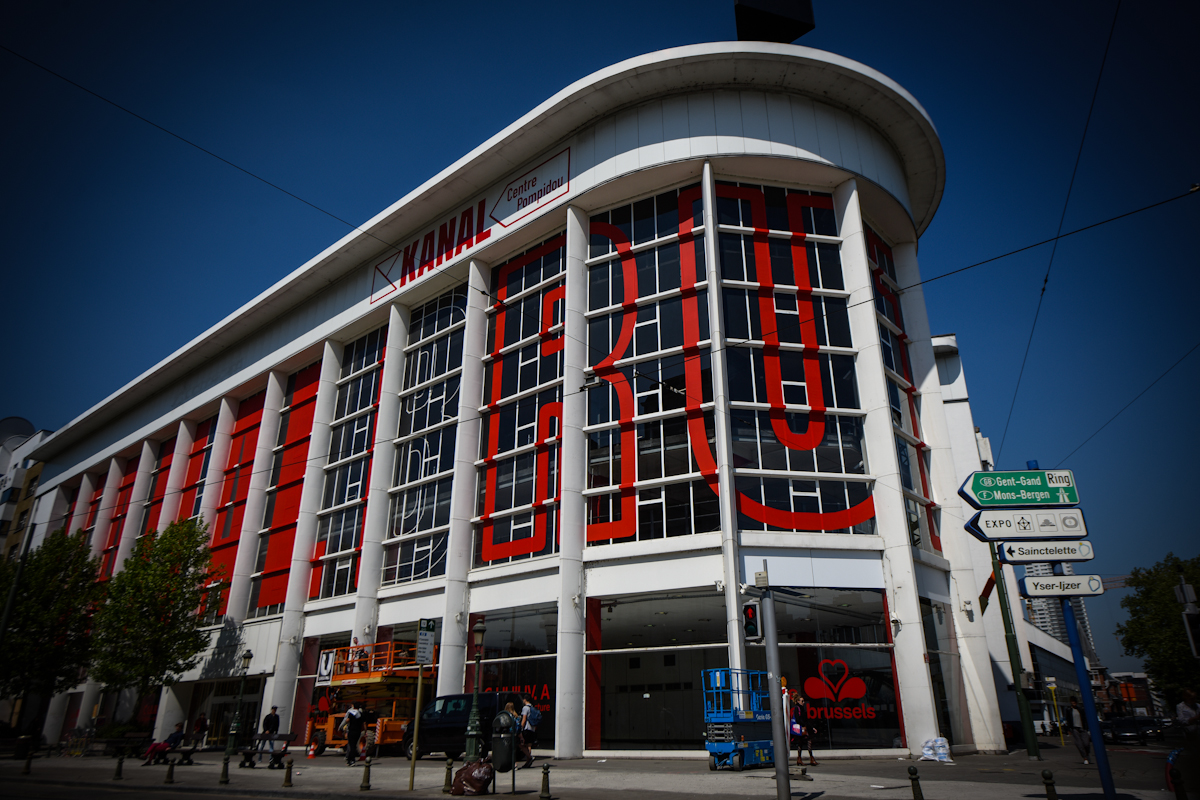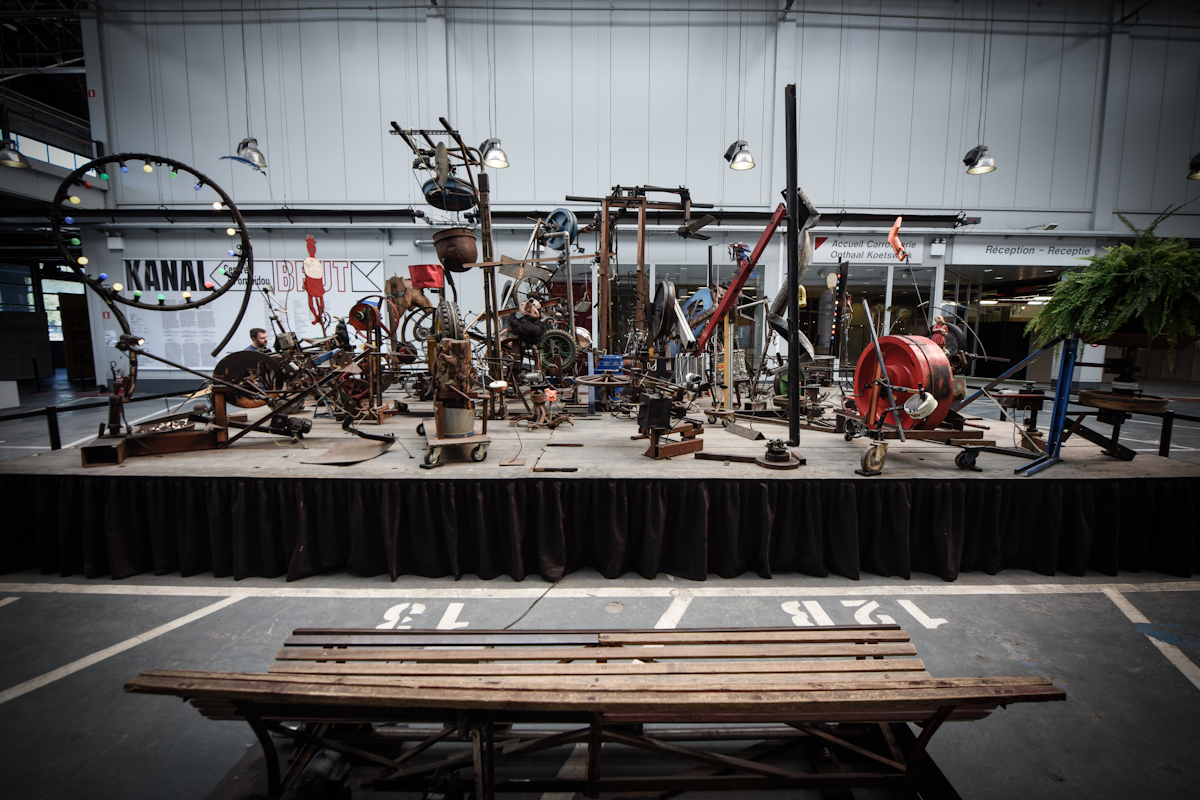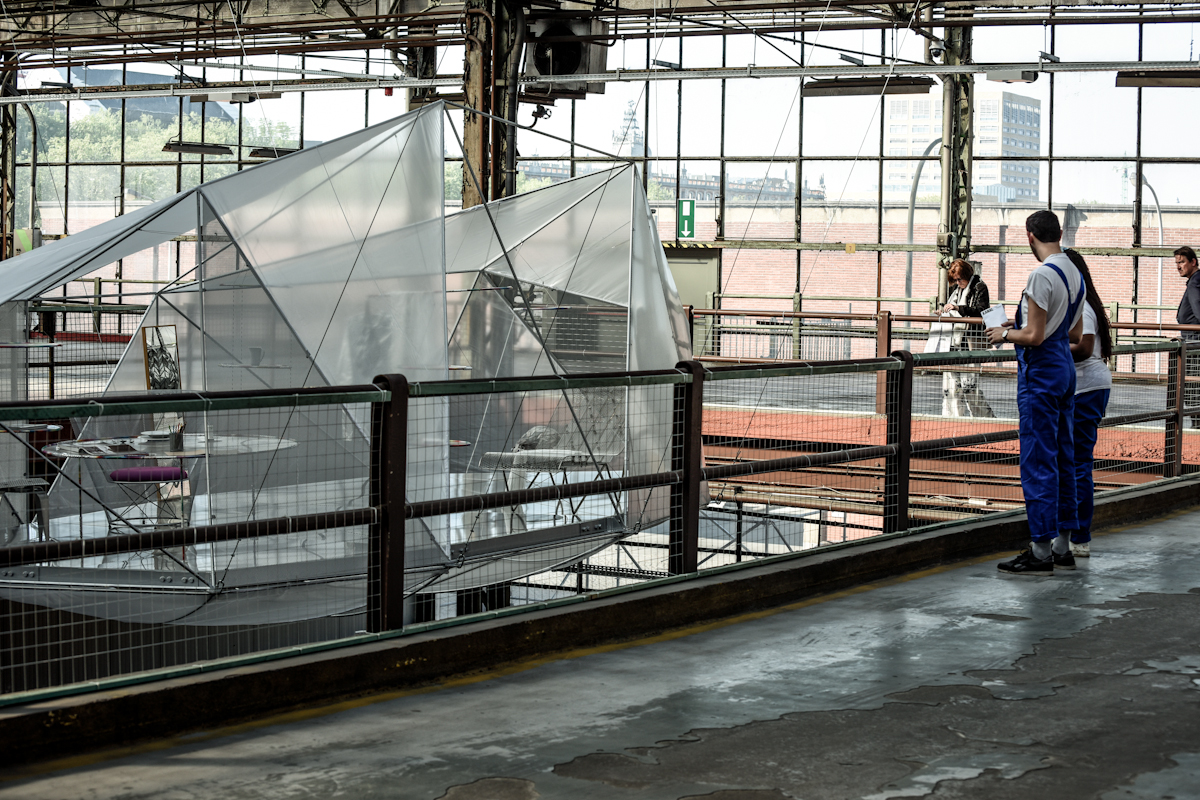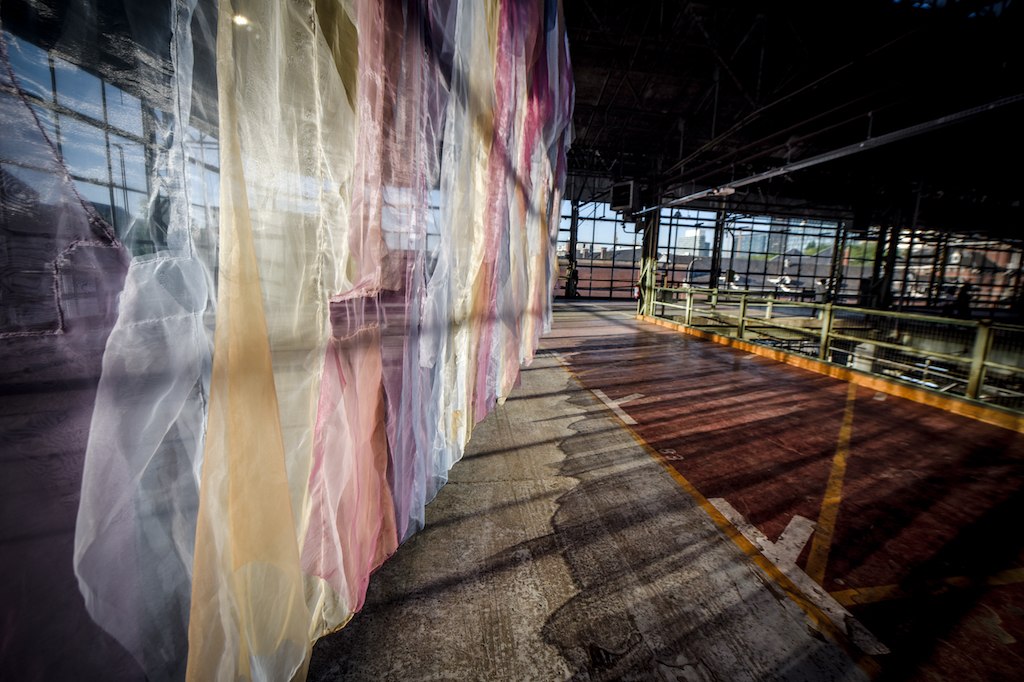[ad_1]

The Kanal–Centre Pompidou, which opened to the public on May 5.
VEERLE VERCAUTEREN
The first thing visitors see (and hear) at Kanal–Centre Pompidou, the Belgian outpost of Paris’s Centre Pompidou that opened just outside Brussels’s city center earlier this month, is a wide, wooden stage laden with 30 motor-driven assemblages. Spinning tires and engine belts, a self-crashing cymbal, and a whirling hoop of parti-colored light bulbs are among the objects here that cavort in a riot of light and sound. This vision of Pandemonium, it turns out, is Jean Tinguely’s 1984 kinetic sculpture L’enfer, un petit début (Hell, A Small Beginning), which evokes the noisy labor that once took place every day here. Through last year, the garage was used to service and show cars manufactured by Citroën, who agreed to leave the space as part of a deal brokered with the city of Brussels in 2015 that involved transitioning the garage into an arts institution.
Once the clanging and thrumming of Tinguely’s sculpture stops, viewers have a quiet moment to observe the palatial hall in which they stand. The walls of Kanal’s showroom–turned–entrance hall soar to almost 70 feet, where they meet a gabled and skylighted ceiling that filters soft light onto the assortment of eateries, design store, and administrative offices below. It’s a space as magnificent as many of the churches and cathedrals that dot the Belgian countryside, and now it’s the site of a major cultural project.
When Kanal is completely renovated it will encompass not only a museum of modern and contemporary art, but also the collections of the local CIVA Foundation, as well as public spaces devoted to culture, education, and leisure. Over the next four years, the 376,000-square-foot building will be transformed into a world-class “cultural city,” as Kanal has referred to itself in press materials.
“It’s the first time that the Brussels region is doing such a significant cultural project,” Yves Goldstein, the director of the Kanal Foundation, which oversees the Kanal–Centre Pompidou, told ARTnews. The building will be “not only a museum but a place to live, a place to meet friends, a place to share things, a place [where people can] formally or informally express their own culture.”
A ten-year partnership between the Centre Pompidou and the Kanal Foundation has been a crucial element of the scheme. The Pompidou will lend works and advise on curatorial matters as Kanal develops its mission and builds its collection. Part of a larger initiative to expand the Pompidou’s reach beyond its base in Paris (the museum also oversees spaces in Malaga, Spain, and Metz, France, and has planned yet another for Shanghai), Kanal is currently showing works by various artists, from Marcel Duchamp to Ron Arad, that are on loan from the Parisian institution’s holdings. It’s hoped that the involvement of the Pompidou, along with the space’s innovative programming, will draw the attention of collectors. “I hope the credibility of this place—the ownership of this place by the Brussels people—makes possible [conversations] with collectors in Brussels,” Goldstein said. This, in turn, will help Kanal be able to “manage a collection” of its own.

Jean Tinguely’s 1984 kinetic sculpture L’enfer, un petit début (Hell, A Small Beginning), as installed at the Kanal–Centre Pompidou.
COURTESY KANAL–CENTRE POMPIDOU
Before large-scale renovations begin in 2019, the space is slated to host a year of programming—a “prelude” of sorts, according to Goldstein—in what the institution calls “garage brut.” “In Brussels, to make things great we have to think a little bit out of the box,” he said. “This building is iconic [and] it was important for us to not close this place for five, six, or seven years but to allow the people to begin to own this place.”
Bernard Blistène, the director of the Centre Pompidou’s Musée National d’Art Moderne, has conceived twelve exhibitions to take place over the next 13 months, to be accompanied by performances and other events, with happenings scheduled to coincide with notable arts festivals held in Brussels, like this month’s Kunstenfestivaldesarts, Design September, and the upcoming edition of Performatik, a performance art biennial that typically occurs in March. Though the space isn’t yet climatically suitable for more delicate artworks, in particular paintings and drawings, the Pompidou has loaned more than 300 pieces in other mediums—such as design, sculpture, installation, video, music, and sound—from its permanent collection of more than 120,000 works. Additionally, Kanal has commissioned works by ten young artists based in Brussels that will ultimately be added to the center’s fledgling collection.
Exhibitions and installations at Kanal are organized into four main sections, with each part labeled according to its space’s former use: “Bodywork,” “New Cars,” and “Showroom” are a few of their names. Red, green, blue, and yellow lines painted on the floor guide viewers through the museum. Follow the red line, and you’ll find yourself passing Franz West’s 1992 sculpture Auditorium, a cluster of couches draped in Persian carpets, and then Petra Blaisse’s silvery work Muted Scenery (2016), which shields a performance space housed in what was previously a truck service section and recalls the industrial curtains that were once used to compartmentalize the garage. Opposite these works, Saddie Choua’s video The Chouas #Episode 5 Am I the Only One Who Is Like Me?, one of Kanal’s newly commissioned pieces, screens among a network of cages where spare car parts had been kept. The video is the fifth episode in her series “Les Chouas,” which focuses on members of her family, including her grandfather, who worked in a garage for 50 years.

Franz West’s 1992 sculpture Auditorium, as installed at the Kanal–Centre Pompidou.
COURTESY KANAL–CENTRE POMPIDOU
Further on, visitors come to what used to be a bodywork shop. Now on view there in place of automobiles is the exhibition “Sheet Steel,” one of three shows at Kanal organized by Centre Pompidou curators. Teasing out the parallel history of cars and sculpture fashioned out of sheet metal, the show places works by the likes of Alexander Calder, Nicholas Schöffer, and John Chamberlain where elegant cars were once designed by Citroën workers. The space has been left so raw, it’s as if the cars only just drove out and will soon be returning for new paint jobs. Squares of metal grille checker the concrete floor; an abandoned red scissor lift is installed near Jose Dávila’s sculpture Make Your Own Sunshine (2013), frozen mid-writhe like a pair of tangled, colorful insect antennae. Loud House (1998), a corrugated metal and polycarbonate resin dwelling by Martin Kersels, rumbles ominously in the middle of the space, thanks to vibrating speakers hidden inside. (Kersels’s piece, along with a few others currently on view at Kanal, has never even been shown publicly at the Centre Pompidou.) Another ominous piece, Robert Rauschenberg’s metal assemblage Oracle (1962–65), can be found a few feet away, installed alongside Roy Lichtenstein’s sculpture Hot Dog (1964). A series of metal chairs by Ron Arad, among them Uncut armchair (1997) and Alufelt chair (1993), gleam in the light that pours through the space’s windows.
I recommend going back out the way you came, passing the name “Georges Pompidou” sculpted in monumental gilded-brass letters—a 1990 work by Raymond Hains—and looking up. Suspended above is architect Toyo Ito’s Pao II: A Dwelling for the Tokyo Nomad Women (1989–2017). It’s a performance space filled with tableware and transparent furniture that, with the triangular pattern pierced through its canvas shell, recalls Ito’s design for the 2002 Serpentine Gallery Pavilion in London. To get a better view, follow the green line on the floor and ascend one of the two ramps climbing to the second story. (Visible from the ramps are an elegant lattice of steel joists and struts on the ceiling, thin Belgian bricks on the walls, and roughly tooled rails, all of which are examples of what Goldstein was referring to when he mentioned Kanal’s “garage brut” character.)

Toyo Ito’s Pao II: A Dwelling for the Tokyo Nomad Women (1989–2017).
VEERLE VERCAUTEREN
In the section “Secondhand Cars for Export,” it becomes obvious why a partnership with the Kanal Foundation at the Citroën garage, with its cavernous rooms, was so enticing to the Centre Pompidou—the space can hold gargantuan works that most institutions would have difficulty displaying. “Station to Station,” an exhibition on view until October, features huge pieces from the Pompidou’s collection, such as the model home Maison Tropicale (Tropical House, 1953) by Jean Prouvé; Ross Lovegrove’s glass work Pavillion Lasvit LiquidKristal, which is being used as a showcase for the creations of up-and-coming designers; and Martial Raysse’s Oued Laou (1971/2014), which conjures the valleys of Morocco and comprises a single palm tree growing out of a circular pile of sand under a circus tent–like roof.
Adjacent to “Station to Station” is the exhibition “To Each His Own House. Housing in the Belgian Congo: 1945–1960,” which demonstrates the forms domiciles often took in equatorial regions during the mid-20th century. Here, these designs act as a wry comment on the utopic but unrealized aspirations of Western modernist designers like Prouvé. One of the works included is Raffaella Crispino’s Untitled (Time Zones), 2015, a newly commissioned piece that includes a drape comprising differently-colored strips of organza, each in the shape of one of the time zones superimposed across the countries of the world.

Raffaella Crispino’s Untitled (Time Zones), 2015, as installed at the Kanal–Centre Pompidou.
VEERLE VERCAUTEREN
On the other side of the complex, there is a six-floor stack of showrooms that overlooks the Square Sainctelette and Place de l’Yser. The exhibition “As Found,” presented by CIVA, tells the story of the Citroën garage through plans, models, and historical and contemporary documents in Showroom 1. Showrooms 3 through 5 host the exhibition “The Site of Film” and include a blacked-out room filled with 16 video works by David Haxton, as well as pieces by Anthony McCall and Dan Flavin.
An architectural model of “A Stage for Brussels,” the winning proposal for the redesign of the Citroën garage by the offices of noAarchitecten, EM2N, and Sergison Bates Architects, is on display in the entrance hall, reminding visitors of how this space—brutal and raw, and also quite beautiful—will change. Work on the redesign, which has been given a pre-tax budget of $147.5 million, is scheduled to begin in fall 2019, with an official reopening set for 2022. But Kanal won’t close completely during that period—Goldstein and his crew have coordinated with the architects to ensure that cultural activities will be able to continue. After all, Bruxellois have come to expect something of the complex—more than 30,000 people visited Kanal during its first ten days of operation, which is hardly a bad start.
[ad_2]
Source link

